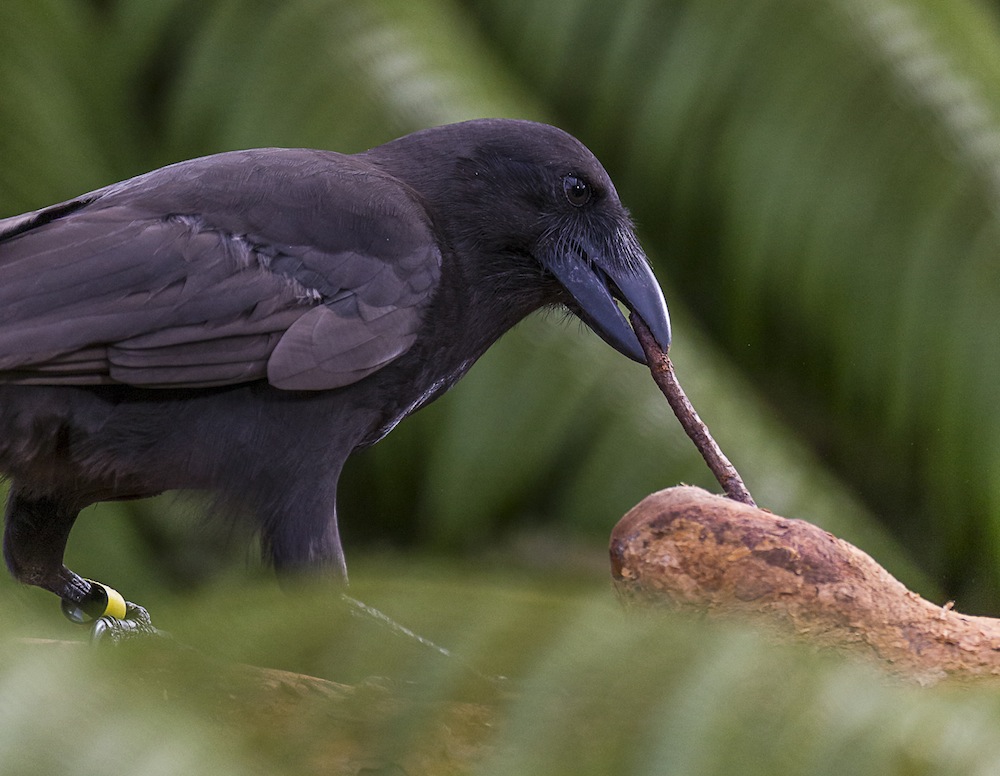2nd Tool-Using Crow Species Found

The critically endangered Hawaiian crow can use sticks to deftly fish for food that is out of reach, according to a new study. The discovery means there are now two known tool-using species of crows.
"The Hawaiian crows are incredibly good at using tools," said lead study author Christian Rutz, a biologist at the University of St Andrews in the United Kingdom. "What we see is similar to the really skilled tool handling in New Caledonian crows."
Until now, New Caledonian crows had been the only corvid (a group that includes crows, ravens and rooks) species known to use tools. These birds have become famous for their expert ability to fashion hooks from sticks to snag larvae and insects from crevices in logs or branches. [Creative Creatures: 10 Animals That Use Tools]
Rutz had studied the New Caledonian crow for more than a decade. In one paper, published in the journal Nature in 2012, he and his colleagues showed how the birds have physical characteristics that enable their tool control: straight bills and very large eyes with a large field of binocular vision.
Rutz told Live Science he wanted to look for other birds that shared these features, thinking those traits could be preadaptations for tool use. That led him to the Hawaiian crow, also called the ‘alalā (pronounced AH-la-la).
The one problem was that the birds had been declared extinct in the wild by 2004. (Just 131 are alive today.) So Rutz got in touch with San Diego Zoo Global, a nonprofit organization that operates the San Diego Zoo and was breeding the 'alalā in captivity in Hawaii. People at the captive breeding facility told him they had sometimes seen the birds use sticks but didn't think much of it.
"I immediately booked my flight to Hawaii," Rutz said.
Get the world’s most fascinating discoveries delivered straight to your inbox.
Tool testing
Even in his first pilot experiments, Rutz said it was clear that the birds could very dexterously handle tools. They would swiftly pick up a stick, discard it if it was not good enough or trim off the edges, and use it for foraging.
"It was mind-blowing to see these birds that hadn't had any specific training start doing these extraction tasks I gave them," Rutz said.
He and his colleagues conducted experiments at two breeding facilities with a total of 104 birds. They gave the crows puzzles where bait was tucked into crevices in a log, so it would be in sight but out of reach. The researchers found that 78 percent of all the birds —and 93 percent of the sexually mature birds—spontaneously used sticks to fish for the food.
The team also gave the same puzzles to Hawaiian crows that had been raised away from the tool-using adults. Even without any adult example to follow or training from humans, the birds started picking up sticks and learning to use tools by trial and error, which suggests there is a genetic component to the species' special ability.
There are no reported sightings of these birds using tools before they went extinct from the wild. And while scientists have recently discovered 700-year-old stone tools crafted by monkeys, there's not really any opportunity to do bird archaeology in this case; the 'alalā tools are made from plants and are thus perishable.
The researchers will likely have to wait until groups of the captive-raised birds are released into the wild to confirm that the species uses tools under natural conditions.
New member of the tool-using club
Considered a mark of high intelligence, tool use was once thought to be a defining feature of humans, but that notion has been dismantled as the list of tool-inventing animals gets longer.
Egyptian vultures use rocks as anvils to open ostrich eggs. Woodpecker finches of the Galápagos use twigs to get grubs from trees. Orangutans make whistles out of leaves. Capuchin monkeys in Brazil use stone tools to crack open cashew nuts. And chimpanzees use twigs to fish for termites — a behavior that primatologist Jane Goodall first described in 1964.
"With two tool-using corvids, the well-known Galápagos finches and one vulture in the list of tool-using birds, we can now make comparisons with avian and primate tool using," Goodall said in a statement about the new study. "Each of these discoveries shows how much there is still to learn about animal behavior, and it makes me rethink about the evolution of tool use in our own earliest ancestors."
Rutz said that having two corvid species that naturally make tools is exciting because it may shed light on why this ability evolved.
New Caledonian crows and Hawaiian crows likely learned to use tools independently. (The species' habitats are separated by a large swath of the Pacific Ocean, and their last common ancestor lived around 11 million years ago.) But both bird species evolved on remote tropical islands, which have quite an unusual set of ecological conditions, such as reduced competition for prey and lower predation risks, Rutz noted. Without the constant need to be on the hunt for food or scanning the sky for predators, birds can focus more on experimenting with objects, he said.
The new findings were reported online today (Sept. 14) in the journal Nature.
Original article on Live Science.



